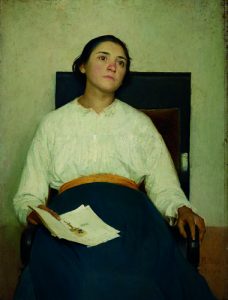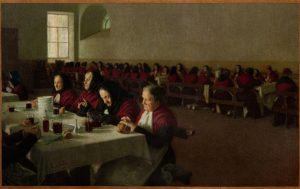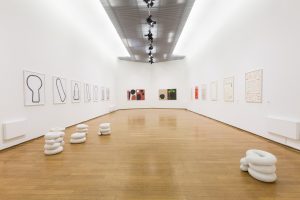At the generous invitation of Maria Giulia Marini and with the support of ISTUD I arrived in Milan on May 6th, 2019 for a week of teaching, learning, and spontaneous exchange. It was serendipity that brought the activities in health, art therapy, and the museum prescription of the Montreal Museum of Fine Arts to the attention of Marini and the theme of serendipity would follow us throughout the week. What follows is a reflection on my different encounters with space, art, language, health care practice, and narrative medicine.
The Theatre
Our first presentation was Tuesday May 7thfor a group of stomach therapy nurses. I wondered what connections they would make between what they were learning about narrative medicine, and more specifically the languages of care, and my own approaches to working with museum art therapy. We gathered in an old community theatre, a wonderful setting for the exchange. The presentation followed a familiar format – I defined art therapy in a museum including the elements of looking at and reflecting on art, of making art in a group and the reflective process that comes at the end of a session where group members tell the story of what their art has to say. I then provided a few case studies from different populations including trauma survivors and breast cancer patients and then introduced the Art Hive which is a creative studio for social inclusion. And finally I spoke about the museum prescription that a community of doctors in Quebec have access to.
Following the presentations by Marini and two esteemed doctors who are using narrative medicine in their practice, the group of nurses were asked to reflect on Van Gogh’s “Starry Night” using simple prompts from Marini’s NM. This exercise would be repeated throughout the week with the different audiences. The differences between the groups’ responses was remarkable. I wondered how the different presentation spaces impacted the responses with some groups seeming to focus on the foreground information while others followed the small houses of the village. Some people felt sad and despair while others felt hopeful. Here I found the bridge between our practices – in the art. For me, art is a powerful tool to unlock narrative and provide a connecting experience between people.
The Hospital
I have been to hospitals. My wife works in a hospital. They are typically environments built to support and facilitate medical intervention. My assessment of this changed on a day trip to Bergamo. The project La Cura e la Bellezza brought together the creative forces of the Humanitas Gavazzeni & Castelli and the Accademia Carrara with the result being an immersive, creative intervention that interrupts, halts, and rearranges the normal flow of narrative in a hospital setting. The impact is deepened when the visitor learns that the staff of the hospital were involved in the selection and placement of work – for who spends more time in the hospital than its workers? The sheer scale of the work was incredible with details, never intended to be seen this way, exploited for their beauty and intrigue. What discussions have these murals now inspired? How have they changed the ecosystem of the hospital for staff, patients and families? The potential feels unlimited.
The Fine Art Museum

Our second tour of the day brought us to the beautiful Accademia Carrara. One piece from the collection that made me pause was Giuseppe Pellizza da Volpedo’s “Ricordo di un dolore”. At the MMFA we have a bereavement group that benefits from art making, art viewing and verbal sharing. Pellizza de Volpedo’s painting was the very embodiment of grief. It spoke volumes through its silence. Later in an adjacent gallery we had the opportunity to share museum art therapy and Languages of Care to a cross section of medical professionals, museum professionals, and interested patrons. The room was adorned with masterpieces we had toured earlier. The setting could not have been more perfect to explore our collective themes.
In my presentation I list the many different populations we are working with: Alzheimer’s, Parkinson’s, Autism, intellectually disabled, breast cancer, deaf culture, trauma, eating disorders, cultural communities, seniors, school aged children and so on. I am very aware of the resources we have as a unique museum. We are very fortunate to have numerous spaces, a large and experienced staff, and strong direction. But I believe that any museum, no matter its size can include some component of social inclusion. The collaboration of the Academia Carrara and Humanitas is an innovative example of this kind of creative thinking. The hospital can come to the museum, but the museum can also come to the hospital.
The City

In the morning I walked. My sense of the rhythms of Milan were beginning to impress upon me. I particularly enjoyed sitting it her parks. On this day I came upon the Galleria d’Arte Moderna Milano. Here I encountered the paintings of Angelo Morbelli. For me, his mastery lay in his ability to render the dusty air that fills his depictions of halls and churches. Of particular relevance to the themes of the week were paintings of the huddled poor (Solatium miseris), of age and memory (Mi ricordo quand’ero fanciulla – Entremets), and of a mother’s tender love for her child (Alba serena – Maternità). I also encountered primary school children being guided through the lavish corridors and galleries. The educator was lively, engaged, and animated. The students were a multi-cultural group of bright faces. This was a reminder of how the passion for the arts can be communicated to the very young and the role that museums continue to play as spaces to inspire awe, wonder, and connection.

Walking out the back of the gallery I found the Padiglione d’Arte Contemporanea Milano and the revolutionary and expressive work of Anna Maria Maiolino. Maiolino’s work was a jolt of alertness in contrast to the sombre tableaus of Morbelli. I was also relieved to finally see the work of a celebrated female artist within an art history that celebrates mainly its men. I collected these memories and included them in my next presentation.
The Classroom
The final two days were spent in the classroom with a cohort of health care professionals. As the days progressed I began to have deeper understanding of Narrative Medicine, and specifically Marini’s Languages of Care. Maria Giulia and I now had our own flow to presenting together, she as my bridge to language and culture. Once again the group had a very particular response to the exercise of reflecting on Starry Night. We finished the day with At Eternity’s Gate – a film about Van Gogh and his descent into illness. It was in many ways another perfect bridge to explore the connections between NM and art.
 On the final day John Launer, MD lectured on his own approach to NM. Within Launer’s style was the familiar stance of the systemically trained family therapist. John appeared to ask questions that capitalized on the autonomy of the individual to come to their own conclusions. The use of questions was like a series of concentric circles that provided both a space and a path. This reminded me of Winnicott’s potential space within which the child is invited to fill up with his images and creativity. John’s regard was entirely positive and pragmatic. His questions were economical without being distanced. He cared but was also skilled at maintaining a boundary that allowed him to be of help without overstepping what kind of help was requested.
On the final day John Launer, MD lectured on his own approach to NM. Within Launer’s style was the familiar stance of the systemically trained family therapist. John appeared to ask questions that capitalized on the autonomy of the individual to come to their own conclusions. The use of questions was like a series of concentric circles that provided both a space and a path. This reminded me of Winnicott’s potential space within which the child is invited to fill up with his images and creativity. John’s regard was entirely positive and pragmatic. His questions were economical without being distanced. He cared but was also skilled at maintaining a boundary that allowed him to be of help without overstepping what kind of help was requested.
Some of the principles John was teaching reminded me of how we work at the Art Hive where the autonomy of the individual is engaged with. At the Hive, participants are greeted as artists and do not bear diagnoses. The principles of practice are inclusion, curiosity, and kindness. Whenever I presented it, there was a lot of energy around the notion of the art hive. This is idea of a creative space that works on the principal of social inclusion seemed to intrigue a number of people and the desire for such studios to exist in Italy was strong.
Home
Upon returning to Montreal I find that I am still unpacking. My shirts and shoes are put away but the layers upon layers of stories that I encountered while in Milan and Bergamo continue to sing, hum, and echo. I am grateful to Maria Giulia for her skill of bringing people together in her synchronistic way. I am grateful to the warm welcome of the ISTUD team; Luigi, Paola, and Antonietta.
The next steps are for us to develop a research collaboration where I can apply some basic practice of the Languages of Care in my art therapy groups and Maria Giulia and her team can analyse the narratives. This will hopefully reveal an exciting development for both of us and create a hybrid of NM that is based in art.
